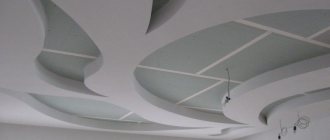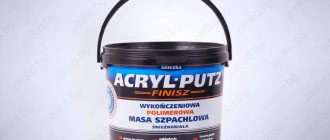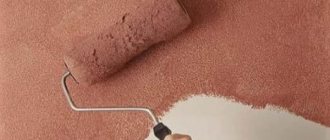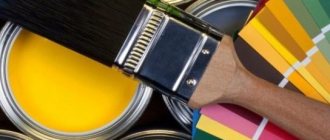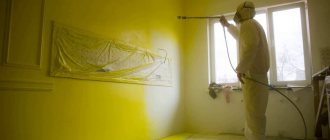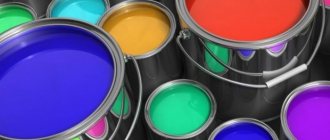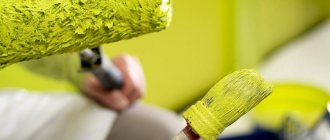For more than half a century, acrylic paint has been used for renovation of premises for walls and other surfaces, including ceilings. This material is environmentally friendly and suitable for various interior works, in particular for painting walls or ceilings. The budget does not always allow for expensive repairs; in this case, acrylic paint for walls and ceilings is perfect. But before applying acrylic paint to a wall or ceiling, you should carefully prepare all the necessary surfaces; if all the work is done correctly, the coating will last for many years.
This material is environmentally friendly
Acrylic paint composition
The material has a synthetic base, with a polymer emulsion that binds pigment and water. But these components are not enough for complete protection in the finishing. Therefore, various additional components are introduced into the composition, which can protect the painted surface from many factors.
In addition to the pigment, the composition contains a stabilizer and coalescent; all these components add additional characteristics that help preserve painted surfaces for a long time, making application convenient. The type of use of acrylic paint directly depends on the composition. Additional ingredients easily allow the emulsion to be used for outdoor work, including in places with high moisture, painting metal surfaces, protecting it from corrosion, and the presence of additives, such as a fungicide, is necessary when painting on wooden surfaces.
- When decorating the exterior of a facade, you should choose a paint that contains an insecticide. This additive will protect the building from damage by insects for a long time.
- When decorating the interior of rooms, painting is always done from the ceiling to avoid unnecessary drops on the walls and floor.
The material has a synthetic base, with a polymer emulsion that binds pigment and water
Coloring instructions
Before applying the emulsion, it must be diluted with water or a special liquid. Typically, manufacturers indicate proportional ratios on the container. For uniform mixing, it is better to use a construction mixer. It is advisable to dilute it in a separate container, and close the rest of the product tightly.
When opening the package, it is better to remove the resulting film, since when mixed later it will form lumps, which will subsequently lead to uneven application.
For even mixing, it is better to use a construction mixer.
Ceiling preparation
- Apply a thin layer of putty to the surface.
- Using sanding material, remove any existing irregularities.
- Remove any accumulated dust.
- Apply primer liquid with a roller.
After the preliminary work, you can begin the main tasks.
By the way. If the surface is well coated with a primer, then much less material will be needed.
Application
- Dip the roller in a special tray filled with acrylic paint. Roll it well so that it lays evenly.
- You need to start applying acrylic paint from the corners. One layer is applied.
- Allow the material to dry completely, only then apply the second layer.
Advice. If the first layer was applied across the room, then the second must be applied along the surface of the room.
After both layers have been applied and dark spots become visible, they are removed using sandpaper and light sanding. It is worth remembering that such defects cannot be painted over.
If black spots appear on the wall, they can be removed with sandpaper
Decorative painting methods
They depend on what you want to see on your wall. Special rollers are suitable for abstraction. If you want to make repeating shapes in different parts of the wall, it is better to make a stencil.
If you want to see the whole working picture, then you need to think about what to draw first and what then. It is better to first draw sketches with a pencil on the walls, and only then start painting.
The stardust effect is often used on the ceiling. This does not require any special tools or effort.
Spray paint onto the work surface. But for a reason. If you took a brush, then you need to squeeze it out, bend it in the opposite direction from the area and release it. The remaining drops from the villi will fly to the surface and leave a beautiful mark.
The choice of paint depends on the room where the renovation is taking place. If you can use any non-staining paint in the hallway, then in the living room or bedroom you need to choose the appropriate one. Use environmentally friendly materials to avoid health problems.
Peculiarities
Acrylic paint can be matte or glossy. But for painting the ceiling, matte is more used, while glossy is used for painting walls. When applied, it is matte and looks velvety on the surface, thereby hiding minor inaccuracies and defects.
The glossy finish, on the contrary, shows all the visible irregularities.
Acrylic paint for walls and ceilings is used very often in decoration. It has earned its popularity for its versatility, and it is also perfectly applied to concrete and wood surfaces.
The material must be used carefully, since acrylate releases minor harmful substances, despite the fact that acrylic paint contains a water-based emulsion. When applied, the room should not be colder than -5. The emulsion is easier to apply with a roller than with a brush.
Acrylic paint for walls and ceilings is very often used in decoration
Methods of dilution and application
When thinning paint, it is important to ensure that it retains its gloss or matte structure. At home, the emulsion is diluted with water. Water is usually added at 10%. If you paint with a spray gun, then it is necessary to dilute the paint.
There is nothing complicated about painting. The main thing is that the walls are well prepared. The liquid material must be applied to the surface in a diluted form. It doesn't take long to dry, it takes about half an hour. When applying, use brushes, rollers or a spray gun.
Advantages
- It contains toxic components.
- Dust does not settle on the surface painted with acrylic water-based paint.
- Acrylic paint also perfectly protects the surface from various bacterial fungi.
- Drying within one hour.
- Ceilings and walls painted with acrylic paint are more resistant to ultraviolet radiation.
- Not afraid of moisture, easily tolerates wet processing.
- If necessary, you can create your own shade by adding color.
Acrylic paint has many advantages
Advantages and disadvantages
Any finishing material used to cover walls, like decorative paints, has its pros and cons. The advantages include:
- Economical use. Conventional paint materials and decorative plaster have a high consumption, unlike decorative paint, which significantly reduces the cost of finishing work.
- Large selection of effects. For those who have an unconventional approach to home decoration, decorative paints are a godsend, because they will help bring almost any idea to life.
- Textured paint, due to the particles included in its composition, will help create an imitation of velvet, a wooden or metal surface, or wet silk on the wall.
- In addition to a wide color palette, the line also includes chameleon colors with a mother-of-pearl effect, which will add variety to the interior and change shade depending on the viewing angle.
- The originality and uniqueness of surfaces treated with this paint.
- Strength and durability. Surfaces painted with decorative finishing materials will last for many years, and there will be no cracks, peeling, or other mechanical defects.
- Ease not only of application, but also of the coloring mixture itself. Due to the light weight of decorative paints, they are easy to work with.
- Unlike wallpaper, dust does not settle on the painted surface.
- Environmental friendliness and safety, which is achieved due to the absence of harmful toxic components in decorative paints.
Among the disadvantages it is worth noting the following:
- small assortment in comparison with other wall finishing materials, for example, wallpaper;
- the need to carefully prepare the surface on which you will apply paint;
- lack of thermal insulation abilities and sound insulation, which, for example, plaster has.
Variety and choice
Glossy
Gloss gives any surface shine and an appropriate shade, but in order to cover it you will need an almost perfect surface, because it shows all the defects.
Matte
The matte variety is more likely to be classified as universal; it is more durable and does not fade over time, maintaining its original appearance.
Acrylic paint is divided into several types according to color
Mother of pearl
This is a special type and contains an inorganic filler. When applied, it forms a visual relief.
Water-based
These are all paints that contain water, and those that do not contain water are perfect for outdoor use.
When choosing a paint material, first of all you should pay attention to the manufacturer, and then to the durability of the selected material.
When choosing a paint material, you should first pay attention to the manufacturer
Decorative paint for walls with the effect of silk and silk threads
Many manufacturers have wall paint that looks like silk. If there are at least several decorative or interior paints, then one of them is silk. The look is very sophisticated and delicate. Suitable for living rooms, bedrooms. In terms of performance (acrylic can be washed with a brush), it can also be used in the hallway, but if you are satisfied with such a “refined” look of your hallway.
When choosing, pay attention to the base. Safety is important for housing
The best option is silk-effect paint based on aqueous acrylic dispersion. It is relatively inexpensive (when compared with silicone, for example), washable, does not fade and can be painted in all colors. Many decorative paints are made on this basis. To obtain paint with a silk effect, a special type of mother-of-pearl and pigment are added to it.
This is what interior silk paint looks like on a wall
Paint consumption is average, you will have to paint in at least two layers. This is for low absorbency or pre-priming. The absorbent surface will require three coats exactly. And paint is not cheap, so it’s better to prime it. If the paint is based on acrylic dispersion, then we use acrylic primer. But it's better from the same company as the paint. There will be no problems with product compatibility.
The disadvantage is that the surface to be painted must be flat. Almost perfectly flat. The second point is that if you want to get “exclusive”, you need to master the application technique. You can, of course, just roll it out with a roller. It will work out well too. But it could be more interesting.
You can wash it with detergent (not abrasive), a rag or a brush. This cleaning does not affect the appearance. In the sense that it is not getting worse. Where the walls are frequently touched, “glossy” areas may remain. If you want this type of finish in your hallway, consider a varnish finish. But this type of paint “breathes”, so if you varnish it, you will lose this effect.
Each company that produces silk-effect decorative paint has a slightly different appearance. Some have multiple options. And not colors, but textures
If you think that silk effect paint looks the same from all manufacturers, you are mistaken. They use different additives, resulting in slightly different surfaces. This type of decorative paint is popular, so some have several paints that give different textures. There are also different application techniques. With their help, you can get different types of surfaces: classic, wet and crushed silk.
Manufacturers
- Tex. Painting with this material is suitable for those who have a small budget. Has excellent moisture resistance.
- Dulux. The material has antibacterial properties and is suitable for painting children's rooms. Suitable for concrete and wood surfaces.
- Tikkurila. This company produces higher quality and more expensive material; manufacturers recommend applying only one layer.
- Caparol. Durable to wear, but expensive.
- Sniezka. High quality, used for interior and exterior work. Water-dispersible paint has a hypoallergenic effect. Waterproof and wear-resistant. Cost is related to quality.
Painting with this material is suitable for those who have a small budget.
Painting ceilings and walls with acrylic paint is not the easiest process. To get an even layer without streaks from application, you need to prepare the surface well and select the right consumables.
Before you start painting, clean the surface of any dirt. Fix all kinds of cracks and holes with putty. Apply the primer with a roller, and sand the area treated with putty to remove any unnecessary irregularities.
Before painting, thoroughly clean the surface
When using a brush, you can hide minor defects on the surface, which will further improve the quality of the work performed.
To avoid divorces, you need to follow the following recommendations.
- Wait until the previous layer is completely dry. If this is not done, stains or stains may form.
- Small cracks are best painted over with a brush.
- Foam rollers are not the best option.
- The second layer must be applied in a different direction to avoid defects.
To avoid divorces, you should follow the recommendations above
Nuances of determining flow
The manufacturer's recommendations located on the packaging will help you correctly calculate the consumption of acrylic paint. They are usually presented at the rate of 1 liter per square meter.
Important! The indicators are based on applying a minimum layer on a perfectly flat wall that has average absorbency.
A significant factor in determining paint consumption is the method of application to the wall:
- Using a spray gun is considered the most economical.
- Next comes the roller.
- Using a brush to decorate a wall with acrylic paint significantly increases its consumption.
Concrete or a plastered wall is a porous substrate, so the volume of paint used will increase by 5-15% of the indicated value on the package.
The next aspect when determining consumption is the quality and, accordingly, the cost of acrylic products. The high price implies good hiding power of the paint, that is, two layers are enough to completely cover the original color of the wall. Cheap analogues will cope with the task in at least three layers. Therefore, less consumption of expensive products will help save money.
In addition to acrylic paint, to decorate the walls you will definitely need an appropriate primer, putty and application tools.
Painting a wooden ceiling
Acrylic paint can be safely used on wooden surfaces. The material is non-toxic and flame resistant.
In order for the wooden surface to be painted well, it must be thoroughly cleaned of dirt.
When selecting a material, you need to look at durability. Degrease the desired surface and impregnate it with impregnation, this will prevent the impact of negative factors.
In order for the wooden surface to be painted well, it must be thoroughly cleaned of dirt.
Wood painting works
- Dilute the paint if it is concentrated.
- Paint one layer, correct any defects with a thin brush. In such cases, the roller should not be used.
- Apply a second coat.
- Allow the second layer to dry; if stains form, lightly sand them.
For painting on wood, follow the technology above
Acrylic emulsion and wall painting
For painting walls, it can be used in any weather conditions, and it is possible to paint not only interior walls, but also the facades of houses.
To create an original author's drawing, not only simple acrylic paints are used, relief pastes are also used. For street art, paint is mixed with a special liquid. After completion of the work and complete drying, the applied paint does not peel off from moisture that has entered it and does not form cracks. The painting will last for many years without losing its beauty.
To completely protect the wall painting and preserve it for many years, you need to apply a transparent matte varnish, which is based on acrylic.
Advantages of acrylic-based paints and varnishes
Water in acrylic paint acts as a solvent. After painting the walls, it dries, and the mixture of polymer emulsion and pigment turns into a thin film. The plastic layer has excellent adhesion and reliably protects the wall from external influences. Acrylic paint coatings have the following beneficial properties:
- Elasticity and plasticity.
- Heat resistance. Provides high-quality external finishing of facades; the film does not crack at low temperatures.
- Resistant to solar radiation. The decorative coating retains its original color for a long time, does not fade or fade.
- Waterproof, which makes acrylic paints optimal for bathroom walls. They can easily withstand cleaning and washing procedures.
- Durability. The polymer film does not deteriorate for 10-20 years.
- Easy to apply. One layer dries completely in 2-4 hours, after which they move on to the next stage. Tools are easy to clean after use.
- No pungent odor during operation and no toxic emissions throughout the entire period of operation. This allows you to decorate a child’s room in an original way without causing harm to health.
- The rich palette of shades is appreciated by professionals and makes it possible to turn any design ideas into reality.
Vivid examples of decorative wall decoration are presented in the photo:
